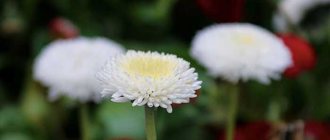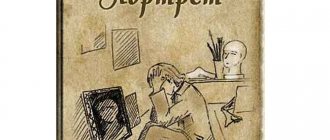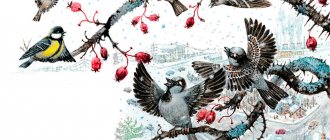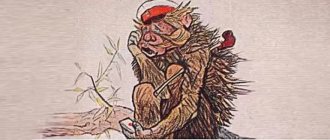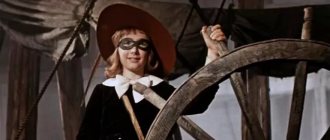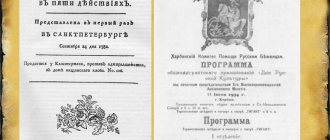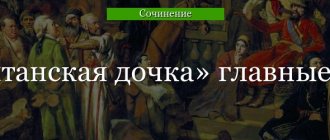Bianki Owl: a summary for the reader's diary. What to write?
The fairy tale “The Owl” was written by Vitaly Valentinovich Bianchi in 1927.
The main characters of the fairy tale are the Old Man, who loved to drink tea with milk, and the Wise Owl, who considered the old man to be her friend. But the old man himself did not consider the owl a friend and thereby offended the owl, which stopped flying at night and catching mice.
The old man just chuckled, what did he care about mice! But the mice multiplied and began to destroy the bumblebees’ nests. There were no bumblebees and no clover in the field. There was no clover and there was nothing for the cow to eat. And the hungry cow stopped giving milk. And there was nothing to whiten the old man’s tea with.
Just then he became thoughtful and asked the owl to apologize for his frivolity. The owl, who also had a hard time without mice, happily accepted the apology and went hunting again. And the old man and the owl lived in perfect harmony.
Brief summary of the tale for the reader's diary:
- The old man offended the owl by saying that she could not be his friend.
- The owl stopped flying to hunt mice, and the mice, having multiplied, destroyed all the bumblebees' nests.
- The bumblebees stopped pollinating the clover, and the clover did not grow.
- The cow had nothing to eat and stopped giving milk.
- The old man had nothing to whiten his tea with, and he asked the owl for forgiveness.
- The owl forgave the old man and began hunting mice again.
Other retellings and reviews for the reader's diary
V.P. Astafiev published the story “The Life of Trezor” in 1978 in the tenth issue of the magazine “New World”. The main character of the story is a dog named Trezor.
A work for children, written in an ironic, playful manner using satire techniques, using the example of kitchen and tea utensils, which are the main characters of the fairy tale, and tells about various human qualities.
Pavka Korchagin is a hooligan and doesn’t really want to study, which is why he is kicked out of school. He is very young and has not even finished school yet. But, nevertheless, he leaves the city when everyone learns the news that the king has been overthrown. The boy is eager to fight, the real one
Another school year is coming, and a new mathematics teacher, Kharlampy Diogenovich, comes to the school. This man immediately stood out among his colleagues, he was very serious and intelligent. During his classes, there was incredible silence and discipline in the classroom.
Source
LiveInternetLiveInternet
Owls are probably one of the most mysterious and enigmatic birds. The secretive nocturnal lifestyle, the “intelligent” look, the silent flight, and the frightening voice struck the human imagination. Owls were revered, dedicated to gods and heroes, they became a symbol of wisdom. In many fairy tales and legends, owls act as advisors, insightful birds, messengers, and bearers of unusual knowledge. The Slavs credit the owl with the role of guardian of underground wealth. These birds have played a significant role in human beliefs and culture since ancient times. An image of a polar owl dating back to the early Paleolithic was discovered on the wall of a cave in France (Armstrong, 1958). Rock carvings of owls are found in various places around the world - in Europe, Australia, America. For a long time, the owl has been considered a symbol of wisdom and knowledge. Among the ancient Greeks, it was the sacred bird of the goddess of wisdom Athena (namely, the little owl). According to one Christian tradition, the owl symbolizes the wisdom of Christ, which manifests itself in the midst of primordial darkness (Saunders, 1995). It was believed that owls have powers that are inaccessible to other animals. This is one of the reasons that they were integral companions of wizards and healers. Thus, the wizard Merlin, a character in the legends of King Arthur, was always depicted with an owl on his shoulder. Among many African peoples, the owl is also considered the bird of wizards and sorcerers. In Lorraine, old maids went into the forest and asked the owl to find a husband.
The owl is probably the most famous “soothsayer” among birds. And it does not necessarily portend bad things, as is often believed. In France they believed that if a pregnant woman heard the cry of an owl, she would give birth to a girl. Residents of South India, having heard an owl “concert,” counted the number of calls. If one foreshadowed approaching death, then two - success in a business that will soon be started, three - someone in the family is getting married, five - a person is about to travel, six - guests should be expected, etc. In Newfoundland (Canada), the cry of the Virginian An eagle owl predicted the approach of bad weather; in England, a change in weather was foreshadowed by the cry of a barn owl (Marcot, Johnson, 2003). In the cultures of many American Indian tribes, the owl personified supernatural knowledge, prophecy, and magical power. Among the Pawnee it was a symbol of protection, among the Ojibwe it symbolized the high status of the spiritual leaders of the tribe, among the Pueblo it was associated with the deity of fertility. The Lenapes believed that an owl seen in a dream became a person’s protective spirit. In the sacred traditions of some tribes, the polar owl personified the north and the north wind.
Among the ancient Mayans, the owl was a symbol of power; its images are found on the bas-reliefs of rulers. The Oglala Sioux revered the snowy owl, and warriors who distinguished themselves in battle were awarded its feathers. In ancient times the Sioux had a special society called the Owl Lodge. Its members believed that the forces of nature would favor the one who deserved the most owl feathers. Some tribes considered the owl's feather a magical talisman. Among the Zuni Indians, mothers placed an owl feather near their child to make it easier for him to fall asleep. Among the Dakota, the rabbit owl was considered the protector spirit of brave warriors. Among the Yakama tribe, the owl was a totem. The Hopi Indians believed that the rabbit owl, being the deity of the underworld, looked after all underground things, including plant sprouts. According to them, the great eagle owl helped fruits grow. The Kwakiutl Indians believed that owls were the souls of people. If you kill an owl, the one to whom the soul belonged will also die. The Tlingit people revered owls very much. Their warriors rushed into battle, howling like owls. The Nevuks believed that brave and virtuous people became Virginia eagle owls after death. The Incas revered owls due to their beautiful eyes (Marcot and Johnson, 2003).
The owl was revered by the Iroquois. California Indians believe that the owl is a deity and guardian of large trees. In the myths of some peoples of Central America, Huitaka is a seductive woman, the patroness of female fertility and the fertility of the fields. For her excessive sensuality and drunken orgies, the gods turned Whitaka into an owl (Fedoseenko, 1998). One of the reasons people have a special relationship with owls is their mysterious night calls. “The voice of an eagle owl is one of the wonders of the night,” wrote ornithologist Yu.B. Pukinsky. “In terms of strength, depth and the impression it makes in the night forest, there is no sound equal to it” (Pukinsky, 1977). It is interesting that the calls of the eagle owl amaze not only people, but also animals. Scientists often heard how wolves, jackals and other animals began to howl in response to his voice. The names of many species of owls among various peoples of the world are onomatopoeic (Holmgren, 1988; Marcot and Johnson, 2003). Many primitive peoples saw the owl as a revered, kind creature; its sinister reputation arose later. The Tungus believe in the protection of owls, consider the owl to be a protector from evil spirits and believe that it hunts for spirits and eats them. The white (polar) owl was considered a holy bird among the Kalmyks. She was called foreshadowing and was treated with great respect. On the island of Samoa, a member of the owl clan, upon finding a dead bird, cries and beats his forehead with a stone until blood flows, and then buries the owl as a fellow owl. In the former GDR, a stylized image of an eagle owl was on the “Nature Conservation” sign. Since the owl was the bird of Athena among the ancient Greeks, the night flight of owls meant the favor of this goddess. As D. Kaigorodov touchingly writes about the little owl: “In his gaze one can see something cunning, crafty, but not evil, but even attractive. “Whoever knows this scoop,” says Brem, “will understand that the Greeks could see in it the favorite bird of the goddess of wisdom, Pallas Athena.” Among the Italians, little owls are true house friends; they often walk around the house, yard and garden with clipped wings, and catch mice everywhere” (Kaigorodov, 1906).
The Greeks depicted the little owl on silver coins of 4 drachmas - tetradrachms, minted in Athens back in the 5th century. BC e., on various measuring vessels as the bird of Athena, the patroness of the city. She used to be the goddess of darkness, which is probably why the connection with night birds arose. Hence, by the way, the modern scientific name of the genus of little owls is Athene. Athena helped in work and battles, personifying wisdom. Her sacred bird was endowed with the same power. The joy of a Greek is understandable; if he met an owl, it means that an intelligent thought will come to him. Little owls were strictly protected; they inhabited the Acropolis in large numbers. It was believed that a magical "inner light" gave the bird night vision. If an owl flew over the Greek army before a battle, it was taken as an omen of victory. Among the Etruscans, the owl was also an attribute of the god of darkness (Marcot, Johnson, 2003). The Romans considered Minerva the goddess of wisdom. The owl was most often depicted sitting at her feet. “The owl of Minerva flies at night,” the Romans said. This meant that good ideas often came at night. An owl often acts as an assistant to a shaman, helps him establish a connection with the world of spirits, gives him the power to see at night, find lost objects, etc. On the northwest coast of Alaska, the Yupik tribe held a special magical ceremony at the end of winter. For her, under the guidance of a shaman, special masks were made, through which the spirits of animals, both dangerous and friendly, manifested themselves. The helping spirit often acted as an owl. Most masks contained snowy owl feathers (Marcot and Johnson, 2003). In Afghanistan, it was believed that the owl gave man flint and iron to make fire. In the Avesta, the Owl is patronized by Mach, the Moon. This means that Owls are related to the occult sciences and secret knowledge is revealed to them. In India, it was believed that Lakshmi, the goddess of wealth, flies on an owl. Therefore, some Indian peoples, primarily Bengalis, still believe that if a white owl flies into a house, this is a good sign, and it means prosperity will come to the house. In China, owls were associated with thunder and the summer solstice. It was believed that images of owls placed in each corner of the house protected it from lightning strikes. The owl was one of the symbols of the yang masculine principle (Marcot, Johnson, 2003). The Chinese considered the owl a symbol of prosperity. Ethnographer A.V. Gura (1997) believes that among the Slavs, a positive assessment of birds of the owl family in folk beliefs is characteristic only of a part of the southern Slavs and is apparently associated with later Muslim influence. This is the idea of the eagle owl as a kind, “holy” bird among the Muslims of Herzegovina, and the sympathetic attitude towards the owl, punished by separation from its cuckoo sister, among the Kyustendil Bulgarians, and the relationship of the owl or owl with a fallen angel in some Serbian and Bulgarian legends. In folklore texts of Herzegovina, the owl appears as the king of birds. There is also a well-known Muslim legend about how an owl saved all the birds from extermination, for which she received divine encouragement from the wise Suleiman. In many areas of Russia, the owl was treated cordially. In fairy tales she was called the “widow owl”, the blond, intelligent little head, the Zalessk lady Ulyana Stepanovna.
According to popular belief, an owl guards treasures. The owl, the “owl’s brother-in-law,” is Leshy’s constant companion, the owls are his messengers, and the wise owl is the forest owner’s advisor. The owl has extraordinary properties. If the heart of this bird is placed, together with its left leg or at least one claw, on a soundly sleeping person, he will immediately begin to tell what he plans to do in the future, and will reveal all his innermost secrets. The claws and bones of eagle owls and owls were used to ward off evil spirits: they were burned and incensed with this smoke in the yard and in the house. The prophetic birds eagle owl and owl mainly predict misfortune - especially if they sit on the corner of a house and start screaming. D. Kaigorodov (1906) told how at the beginning of the 20th century “poultry factories” began to send their procurers to the region of the Don Army to procure owls. For the first two years, no one bothered the agents, the owls were shot, and in the third year the Don people greeted them almost with blows: due to the strong decrease in the number of owls, many mice bred. In Ukraine there is a belief that an owl screeches when a child is born. An affectionate attitude towards the eagle owl can be heard in the Ukrainian folk song “Oh, don’t scare, little scare.” The scarecrow in it says: “How can you not frighten me: even if you want to virubati, call me a nest somewhere, keep the little children warm.” The following sayings about the owl are known: blind during the day, sighted at night, it is the cat who catches mice; flies all night - catches mice, and when it becomes light - flies into a hollow to sleep; if there are a lot of owls, the harvest will be good; an owl screams at night before rain and cold; an eagle owl screams at the thaw; an owl in a hollow - to the wind, in a dry forest - to rain; the owl screams - to the cold. Owl, who looked into your round yellow eye, knows the great secret of miracles. Didn't you reign in Heaven? In their silent failures, there, high, In the blue abysses, your sign has not disappeared to this day. Who at midnight read under the flawed Moon The yellowed chronicle of days, He understands me without words, and now he is with me, Above one line, In my song, In one string, which rattles for the glory of the Universe. Oh, wise bird, whose gaze penetrates the darkness, In the night, where those of the day see nothing, You sat on the terrible hut of Yaga, You looked into the eyes of noble Athena, You were behind the shoulders of all the sorcerers, You cut through the night valleys with your wing, Bringing up visions broadcast dreams On the witch's stems of midnight flowers, From which the darkness, having received a breath, communicates your sign to Our dreams, - I know, someday in the abysses, far away, The luminary of the whirling days will go out, But in the new primeval nights, in the mixing of darkness and lights, Before Through Chaos, the immeasurable yellow eye will be lit with new creativity. Konstantin Balmont
Analysis of the work
Vitaly Valentinovich divides his newspaper into 12 issues, according to the number of months in the year. They tell about life in the wild and the needs of forest animals.
Summary
Each issue of the newspaper reflects its own characteristics. The very first month begins with the vernal equinox, when spring comes into full force. On this day, people bake various treats and release songbirds, who became the characters in “Forest Houses.” Children hang bird feeders and rooks arrive.
With the melting of snow, many disasters occur: floods begin, and this is destructive for nests and burrows. Changes in nature occur every day - some birds and animals have offspring, buds appear on trees, and primroses appear from under the snow. The seeds are waiting to sprout under the snow, and some of them are clinging to the fur of animals.
Animals change their color, starlings and nightingales arrive. Flies and some animals wake up. The grass begins to turn green, and a little later mosquitoes, butterflies and bugs appear. In spring, animals have a lot to worry about. But they also face troubles - the destruction of nests, the threat from predators, and also the hunting season.
With the onset of summer, forest animals are in full swing. They have already acquired offspring, now they need to feed the cubs. The surrounding world takes care of its inhabitants; the forest is full of berries, roots, and herbs. At the end of summer, grain crops begin to ripen, and a little later people mow the grass for hay.
In August, nature reminds you that it will soon get colder. Many birds are preparing to fly away, the chicks are leaving the nests and getting used to independent life. Spiders weave webs, strawberries turn red in the meadows, and mushrooms appear.
With the onset of autumn comes the time to say goodbye to your native land . The sky begins to frown more and more often, the forest changes its colors. The leaves are turning yellow, and cranberries are ripening in the swamps. Birds are preparing to fly to warmer places. All living beings prepare supplies for the winter. Even small mice hide spikelets in holes.
Before the onset of cold weather, the main concern of animals is to replenish their pantries. There are those who do not need this; they have another task - to fatten up, eat more fat and hibernate. Animals change their fur color in late autumn. It gets very cold in winter. But for those who are full, this is not scary.
The forest is the father, forest flora and fauna are his children. They are interconnected, any change will affect everyone.
Retelling plan
Based on the summary of “Forest Newspaper” by Vitaly Bianki, you can draw up a concise retelling plan. It consists of the following points:
- Equinox day.
- Birds fly in and build nests.
- The first flowers appear and the buds swell.
- Summer concerns of birds and animals.
- Berries and mushrooms appear.
- Replenishing supplies for the winter.
- The arrival of autumn, the accumulation of fat reserves.
- The cold weather is coming.
Main thought
The main characters in the work are birds, forest animals and people. If all living beings live in peace and harmony, this will have a positive effect on the environment . Nature is the home of all its inhabitants. Man’s duty is to protect the natural world, help it, and in no case destroy it.
The writer with his work wanted to convey to readers that it is necessary to love nature, animals, plants. And he also talked about the fact that just as for a person there is nothing sweeter than home, so for a bird there is nothing dearer than its native nest.
This work teaches the following:
- love, protect and understand nature;
- takes care of yourself and loved ones;
- notice the beauty around you;
- forethought;
- love your native land.
Thus, the most important task of man is to get closer to nature. Knowledge helps to treat her more carefully, love and care for her.
Owls in mythology
“The owl is an ambivalent symbol. Bird of wisdom, but also of darkness and death. American Indians: wisdom, prophecy. Celts: chthonic symbol, "night witch", "corpse bird". China: evil, crime, death, horror, ungrateful children. On funeral urns it symbolizes death.
Christianity: Satan, powers of darkness, solitude, sorrow, desolation, bad news. The cry of an owl is a “song of death.” The owl also symbolized the Jews, who preferred darkness to the light of the Gospel. Egypt: death, night, coldness. Greco-Roman tradition: the eagle owl symbolized wisdom and was dedicated to Afitsa (Minerva). The owl was an attribute of the god of darkness and night among the Etruscans. Jewish tradition: blindness. Hinduism: emblem of Yama, god of the dead. Japan: death, bad omen. Mexico: night, death. A well-known symbolic bird in Europe, an attribute, Pallas Athens (“to deliver owls to Athens” is to do something unnecessary). The allegorical meaning of owls is twofold. Owls (and sometimes owls, which are not separated from them) in human ideas are equipped with a wise, penetrating gaze, are reasonable, thoughtful, especially since they are known to have the ability to see at night. “Owls, due to their nature, are of exceptional importance, primarily because they keep their watch at night, therefore they can be likened to vigilant guards and others who belong to the same classification” (Böckler, 1688). One non-European symbolic example is also mentioned here: “Tatar Khan introduced a black owl on his golden shield, for the very first Tatar king, Genghis Khan, saved his life through this bird.” As a symbol of knowledge and erudition, dispelling the darkness of ignorance, this bird is often depicted in the logos of scientific publications and the book trade, especially since the goddess Athena (Minerva) also embodied wisdom. In popular beliefs, the owl and owl often had a negative meaning, especially due to the fact that they lead a nocturnal (photophobia) lifestyle - because of their unsociability and unsociability, silent summer and the specific sounds they make. In doing so, they represent an aversion to spiritual light, reinforcing the positive perception of Jesus Christ in the “Night of the Suffering and the Dead.” The Baroque poet Hochberg (1675) talks about the successful fight of daytime birds when attacked by night creatures: “A little owlet spotted in the poultry house was torn by the whole poultry house with drekoly, screaming. Whoever strives for the church curtain will also have a similar fate.” In Judaism, the female nocturnal demon Lilith is depicted in the company of a nocturnal bird - an owl; in Hinduism, the owl serves as a mount for the terrible dark goddess Durga in the form of her manifestation when she is called “Kamunda”; Among the Yucatan Mayans, the death god Gunhau often carries the head of an owl with him. In China, the owl is a negative resemblance to the phoenix and is considered to cause disease due to the fact that the large, motionless eyes of an owl are considered "demonic"; This attitude towards owls is also explained by the existence of a belief that young owls learn to fly only after they mercilessly scratch out the eyes of their parents. However, during the Shan dynasty, owls acquired a positive meaning, as evidenced by the numerous bronze figurines dating back to that time. In the pre-Aztec culture of Ancient Mexico (Teotihuacan), the rain goddess was revered in the form of a sacred owl, but among the Aztecs the owl symbolized a certain demonic night creature and evil omens. All these ambiguities can be illustrated by the saying: “What an owl sings to one, a nightingale sings to another.” The owl is like the soul of an animal. Wooden medallion in the shape of a heart.
Tsimshian Indians. Northwest Coast of North America - Owl on a red-figure Attic Scythian vessel, c. 470 BC Owl attacked by birds. V. X. von Hochberg, 1675 // Discretion is more valuable than eloquence. symbol of wisdom. dedicated to Minerva “not so much for the sweetness of her voice, but for the seriousness of her gaze and the nobility of her appearance. On the other hand, being a bird of the night, it symbolizes the time of day when silence surrounds us and we can concentrate, digest and organize our thoughts.” The battle between the owl and the crow Wisdom cannot stand noise. The owl, as previously shown, being the bird of Minerva, is a symbol of wisdom, and the crow, an unpleasant and noisy bird, is a symbol of stupidity and insolence, and between them, as between noisy folly and wisdom, there are always disagreements, accompanied by battles and fights. //Night is the best advisor. a symbol of mature reflection, the need to “think and meditate on this at night on our pillow. symbolic of the night. “Before you bring your work into the bright light, think about it well at night. . In Christianity Because the owl hides in the dark and is afraid of the light, it has become a symbol of Satan, the prince of darkness. The owl is said to deceive other birds by luring them into bird catchers' nets, just as Satan deceives people. In addition, the owl symbolizes loneliness, and it is in this sense that it appears in scenes depicting hermits praying. However, since ancient times it has been believed that the owl is endowed with wisdom, and it is in this meaning that it is present in the images of St. Jerome. The owl also has another meaning, in which it acts as an attribute of Christ, who sacrificed Himself for the salvation of mankind: “To give light to those who sit in darkness and in the shadow of death...” (Luke 1:79). This explains the presence of the owl in the crucifixion scenes. Now an emblem of insight and bookish erudition, the owl had ominous, even terrifying symbolism in some ancient cultures, especially China. Silent night flight, glowing eyes and eerie screams influenced the fact that the owl was associated with death and occult powers. She was credited with the gift of prophecy, possibly due to her ability to see in the dark. It was considered the bird of death in Ancient Egypt, India, Central America, North America, China, and Japan, and in some traditions the owl was revered as the guardian of the night and the messenger of the underworld, called upon to escort souls to the kingdom of the dead, for example, in India. Among the plains Indians of North America, owl feathers in their headdress had a protective symbolic meaning for the same reason. In China, young owls were credited with the habit of pecking out the eyes of their mothers. The owl also belonged to the “yang” symbol, which had a rather negative, destructive connotation; the owl was associated with thunder and the June solstice. As a creature that leads a nocturnal lifestyle and is generally very mysterious, the owl has become in Christianity a symbol of evil spirits and witchcraft, its images in the Christian tradition are a symbol of the blindness of unbelief. Associations of the owl with wisdom originate from ancient Athens, where the owl was considered a companion and attribute of the goddess of wisdom and learning, Athena Pronoia (the Seer). It is in this capacity that the image of an owl is often found on Greek coins. From the Athenian tradition comes the wise owl in European fairy tales and fables, the emblematic image of wisdom - an owl sitting on a stack of books, and the idiom "learned owl" in reference to scientists blinking, like these birds, behind thick glasses.
The Bianchi Owl
Genre: literary fairy tale
Theme of the work: man and animals
The main characters and their characteristics
What is the work about (1-2 sentences - the shortest summary)
The old man offended the Owl by not considering her a friend, and the owl stopped scaring the mice. The old man was left without milk, and he had to ask the owl for forgiveness.
Plot - summary
I liked how the author describes the relationships in nature. He showed that the owl does not just catch mice, but plays an important role in the food chain. And there will be no owl, there will be no grass, which means there will be no milk.
Outline of the work for retelling
Everything in nature is interconnected and everything depends on each other.
What does this book teach
The fairy tale teaches us to love nature, take care of it and understand the invisible threads that exist in nature. Teaches you to value your friends and never offend them, to be able to forgive.
